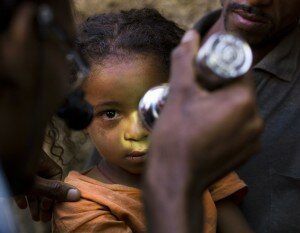This post is a republication of a press release generously provided by Sightsavers. The image was taken in Ethiopia earlier this week of Bigiltuu Kefeni, 5, from Keta town in the Oromia region of Ethiopia. Bigiltuu is one of the first of the four million people to be examined as part of the massive global project. Credit: Dominic Nahr/Magnum Photos/Sightsavers.
 Global efforts to eliminate the most common infectious cause of blindness in the world has taken an ambitious step forward as mapping of the disease trachoma begins in Ethiopia this week. The global survey, funded by the UK government, aims to see a sample of four million people across more than 30 countries examined by March 2015 to identify where people are living at risk from this neglected tropical disease (NTD) and where treatment programmes are needed.
Global efforts to eliminate the most common infectious cause of blindness in the world has taken an ambitious step forward as mapping of the disease trachoma begins in Ethiopia this week. The global survey, funded by the UK government, aims to see a sample of four million people across more than 30 countries examined by March 2015 to identify where people are living at risk from this neglected tropical disease (NTD) and where treatment programmes are needed.
The blinding disease is already known to affect more than 21 million people1 but it is estimated that an additional 180 million people
worldwide2 live in areas where trachoma is highly prevalent and are at risk of going blind. Supported by the UK government, a consortium of the International Trachoma Initiative (ITI), other NGOs and academic institutions, led by Sightsavers, will carry out the mapping in more than 30 of the world’s poorest countries, including over one third of African countries, in the next three years.
The first survey started this week in Oromia, in central Ethiopia where 22 million people live in suspected endemic areas. Five-year-old Bigiltuu Kefeni, and her family from Keta Town in the region were among the first of four million people to be examined by a specially trained ophthalmic nurse. The availability of water, sanitation and hygiene facilities in their village was also recorded, with all data captured on a smart phone. The remaining affected districts in Oromia will be mapped in the coming months and results uploaded to the open-access disease maps via www.trachomaatlas.org.
ITI and The Fred Hollows Foundation are supporting Ethiopia’s Ministry of Health to deliver the programme in Ethiopia. Dr Danny Haddad, director of the ITI commented: “It is exciting to launch this global survey in Ethiopia. Blinding trachoma has a devastating personal and economic impact on people living in some of the world’s poorest countries. By working with a group of NGOs with trachoma expertise, the consortium is bringing together the best available resources for planning, implementation and research to achieve maximum impact with our mapping.”
Dr Anthony Solomon, Senior Lecturer at the London School of Hygiene & Tropical Medicine and Chief Scientist for the mapping project, said: “Ethiopia may be the country most profoundly affected by this cruel disease, so I am delighted that we are starting this ambitious project here. The completion of the mapping of this region, Ethiopia and ultimately all endemic countries will mean the scale of the problem can be understood and it will be clear exactly where trachoma is putting people at risk of blindness so that the resources can be mobilised to enable us to end this dreadful condition.”
Trachoma, caused by a bacterial infection, is a significant public health threat in the developing world and is confirmed endemic in 53 countries3. It is a disease of poverty that mainly affects women and children who live in hot, dry and dusty areas where there is a lack of water and sanitation. Repeated infections, if untreated, can lead to blindness.
The World Health Organization (WHO), which has resolved to eliminate the disease by 2020, has developed a proven method to treat and prevent trachoma – the SAFE strategy4 – that is already being used in many countries. The global mapping project is part of the UK’s commitment to the global push towards the elimination of neglected tropical diseases (NTDs) and the first critical step towards the end of this specific disease.
__________________________________________________________________________________________
